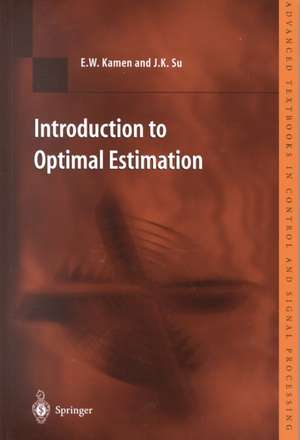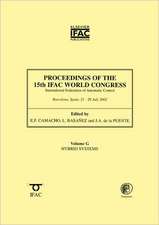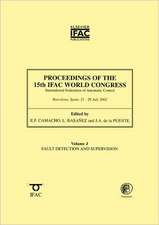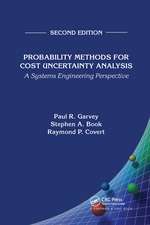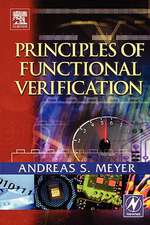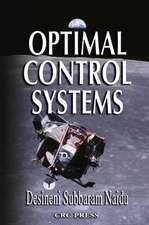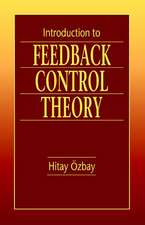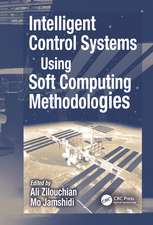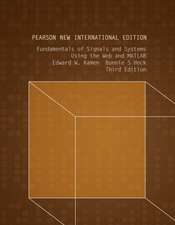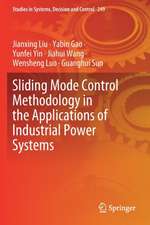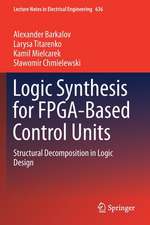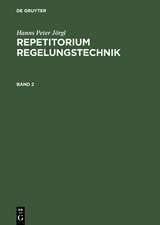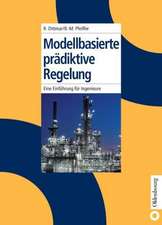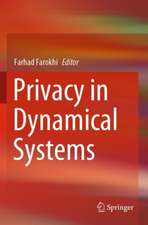Introduction to Optimal Estimation: Advanced Textbooks in Control and Signal Processing
Autor Edward W. Kamen, Jonathan K. Suen Limba Engleză Paperback – 30 sep 1999
Din seria Advanced Textbooks in Control and Signal Processing
- 17%
 Preț: 460.72 lei
Preț: 460.72 lei - 15%
 Preț: 659.35 lei
Preț: 659.35 lei -
 Preț: 375.68 lei
Preț: 375.68 lei - 15%
 Preț: 593.42 lei
Preț: 593.42 lei - 15%
 Preț: 616.31 lei
Preț: 616.31 lei - 18%
 Preț: 991.55 lei
Preț: 991.55 lei - 20%
 Preț: 572.72 lei
Preț: 572.72 lei - 15%
 Preț: 502.22 lei
Preț: 502.22 lei -
 Preț: 393.90 lei
Preț: 393.90 lei - 15%
 Preț: 499.26 lei
Preț: 499.26 lei -
 Preț: 394.29 lei
Preț: 394.29 lei - 15%
 Preț: 582.30 lei
Preț: 582.30 lei -
 Preț: 358.79 lei
Preț: 358.79 lei - 15%
 Preț: 652.49 lei
Preț: 652.49 lei -
 Preț: 396.40 lei
Preț: 396.40 lei - 15%
 Preț: 505.83 lei
Preț: 505.83 lei - 19%
 Preț: 564.48 lei
Preț: 564.48 lei - 20%
 Preț: 333.72 lei
Preț: 333.72 lei -
 Preț: 402.00 lei
Preț: 402.00 lei - 15%
 Preț: 502.22 lei
Preț: 502.22 lei - 15%
 Preț: 658.05 lei
Preț: 658.05 lei - 15%
 Preț: 592.95 lei
Preț: 592.95 lei -
 Preț: 392.75 lei
Preț: 392.75 lei - 23%
 Preț: 669.20 lei
Preț: 669.20 lei - 19%
 Preț: 475.27 lei
Preț: 475.27 lei - 19%
 Preț: 531.49 lei
Preț: 531.49 lei - 19%
 Preț: 535.15 lei
Preț: 535.15 lei - 15%
 Preț: 711.40 lei
Preț: 711.40 lei - 15%
 Preț: 474.82 lei
Preț: 474.82 lei -
 Preț: 390.46 lei
Preț: 390.46 lei -
 Preț: 391.99 lei
Preț: 391.99 lei - 15%
 Preț: 532.05 lei
Preț: 532.05 lei - 15%
 Preț: 506.48 lei
Preț: 506.48 lei - 15%
 Preț: 597.01 lei
Preț: 597.01 lei - 21%
 Preț: 467.48 lei
Preț: 467.48 lei
Preț: 396.02 lei
Nou
Puncte Express: 594
Preț estimativ în valută:
75.78€ • 81.03$ • 63.18£
75.78€ • 81.03$ • 63.18£
Carte tipărită la comandă
Livrare economică 18 aprilie-02 mai
Preluare comenzi: 021 569.72.76
Specificații
ISBN-13: 9781852331337
ISBN-10: 185233133X
Pagini: 400
Ilustrații: XIV, 380 p.
Dimensiuni: 155 x 235 x 21 mm
Greutate: 0.6 kg
Ediția:1999
Editura: SPRINGER LONDON
Colecția Springer
Seria Advanced Textbooks in Control and Signal Processing
Locul publicării:London, United Kingdom
ISBN-10: 185233133X
Pagini: 400
Ilustrații: XIV, 380 p.
Dimensiuni: 155 x 235 x 21 mm
Greutate: 0.6 kg
Ediția:1999
Editura: SPRINGER LONDON
Colecția Springer
Seria Advanced Textbooks in Control and Signal Processing
Locul publicării:London, United Kingdom
Public țintă
Professional/practitionerCuprins
1 Introduction.- 1.1 Signal Estimation.- 1.2 State Estimation.- 1.3 Least Squares Estimation.- Problems.- 2 Random Signals and Systems with Random Inputs.- 2.1 Random Variables.- 2.2 Random Discrete-Time Signals.- 2.3 Discrete-Time Systems with Random Inputs.- Problems.- 3 Optimal Estimation.- 3.1 Formulating the Problem.- 3.2 Maximum Likelihood and Maximum a posteriori Estimation.- 3.3 Minimum Mean-Square Error Estimation.- 3.4 Linear MMSE Estimation.- 3.5 Comparison of Estimation Methods.- Problems.- 4 The Wiener Filter.- 4.1 Linear Time-Invariant MMSE Filters.- 4.2 The FIR Wiener Filter.- 4.3 The Noncausal Wiener Filter.- 4.4 Toward the Causal Wiener Filter.- 4.5 Derivation of the Causal Wiener Filter.- 4.6 Summary of Wiener Filters.- Problems.- 5 Recursive Estimation and the Kaiman Filter.- 5.1 Estimation with Growing Memory.- 5.2 Estimation of a Constant Signal.- 5.3 The Recursive Estimation Problem.- 5.4 The Signal/Measurement Model.- 5.5 Derivation of the Kaiman Filter.- 5.6 Summary of Kaiman Filter Equations.- 5.7 Kaiman Filter Properties.- 5.8 The Steady-state Kaiman Filter.- 5.9 The SSKF as an Unbiased Estimator.- 5.10 Summary.- Problems.- 6 Further Development of the Kaiman Filter.- 6.1 The Innovations.- 6.2 Derivation of the Kaiman Filter from the Innovations.- 6.3 Time-varying State Model and Nonstationary Noises.- 6.4 Modeling Errors.- 6.5 Multistep Kaiman Prediction.- 6.6 Kaiman Smoothing.- Problems.- 7 Kaiman Filter Applications.- 7.1 Target Tracking.- 7.2 Colored Process Noise.- 7.3 Correlated Noises.- 7.4 Colored Measurement Noise.- 7.5 Target Tracking with Polar Measurements.- 7.6 System Identification.- Problems.- 8 Nonlinear Estimation.- 8.1 The Extended Kalman Filter.- 8.2 An Alternate Measurement Update.- 8.3 Nonlinear System Identification UsingNeural Networks.- 8.4 Frequency Demodulation.- 8.5 Target Tracking Using the EKF.- 8.6 Multiple Target Tracking.- Problems.- A The State Representation.- A.1 Discrete-Time Case.- A.2 Construction of State Models.- A.3 Dynamical Properties.- A.4 Discretization of Noise Covariance Matrices.- B The z-transform.- B.1 Region of Convergence.- B.2 z-transform Pairs and Properties.- B.3 The Inverse z-transform.- C Stability of the Kaiman Filter.- C.1 Observability.- C.2 Controllability.- C.3 Types of Stability.- C.4 Positive-Definiteness of P(n).- C.5 An Upper Bound for P(n).- C.6 A Lower Bound for P(n).- C.7 A Useful Control Lemma.- C.8 A Kaiman Filter Stability Theorem.- C.9 Bounds for P(n).- D The Steady-State Kaiman Filter.- D.2 A Stabilizability Lemma.- D.3 Preservation of Ordering.- D.5 Existence and Stability.- E Modeling Errors.- E.1 Inaccurate Initial Conditions.- E.2 Nonlinearities and Neglected States.- References.
Textul de pe ultima copertă
This book, developed from a set of lecture notes by Professor Kamen, and since expanded and refined by both authors, is an introductory yet comprehensive study of its field. It contains examples that use MATLAB® and many of the problems discussed require the use of MATLAB®. The primary objective is to provide students with an extensive coverage of Wiener and Kalman filtering along with the development of least squares estimation, maximum likelihood estimation and a posteriori estimation, based on discrete-time measurements. In the study of these estimation techniques there is strong emphasis on how they interrelate and fit together to form a systematic development of optimal estimation. Also included in the text is a chapter on nonlinear filtering, focusing on the extended Kalman filter and a recently-developed nonlinear estimator based on a block-form version of the Levenberg-Marquadt Algorithm.
Caracteristici
A strong technical reference book for both students and engineers Authors are well-respected in their field
